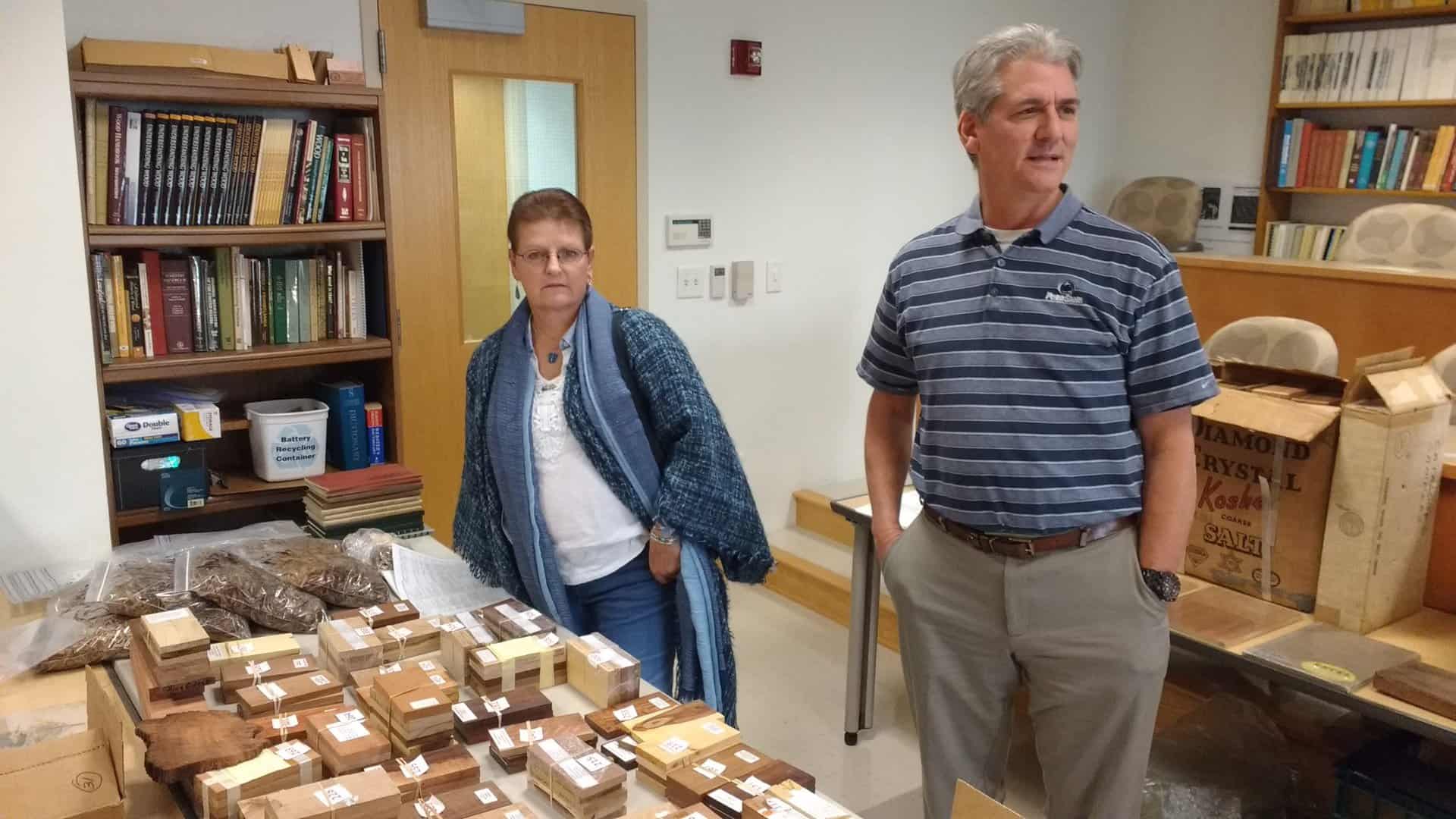
IWCS Resources Available:
IWCS Wood Specimen Kit order form with complete details as of 9 October 2025 – In response to the requests of wood collectors, the International Wood Collectors Society endeavors to supply wood specimens of 80 species. Prepared specimens measuring 0.5 x 3 x 6 inches are available in kits with a minimum of 40 specimens of the buyer’s choice up to the complete 80-piece set. Whether used for studying wood structure or identification, these specimens will prove to be a valuable resource of information to collector, tradesman, craftsman, teacher, or hobbyist alike. Specimens are shipped in a padded cardboard box and are numbered to correspond to the list below. Also included is an eight-page wood identification bulletin with an identification keys and photos.
IWCS Booklet: A Guide for Developing A Wood Collection is not currently available for purchase.
Buy, sell or trade wood specimens: Member Listings and Requests
The Formidable Challenge
Can you picture how complex it would be if you decided to collect samples of as many of the woods of the world as you possibly can? For a start, did you know that there are over 50,000 species of wood? What a formidable job, even if they were easy to find and collect.
Next, practically all countries in the world have trees and therefore wood species. Even if you could just travel to each country and have samples of that country handed to you, it would be an expensive and formidable job. However, it is not that easy. Wood species collectors must find and make their own samples. For one person using their own efforts, it would become a full time pursuit …. and you had better be a multi-millionaire, too!
You would have to travel to just about every region of the earth where trees exist — to the frigid arctic, the hottest bug infested forests teaming with poisonous snakes and wild animals. You would find yourself in politically hostile countries, swamps, vast scorching deserts and every harsh element of the earth just to collect your samples! Does it start to sound like collecting wood samples is impractical, even impossible?
Not for the Academically Faint
Even if you could accomplish such an amazing venture, how would you identify the trees to get the wood samples you want? Just being able to identify a tree may be a difficult job even for professional dendrologists, and it is harder for a piece of wood. This leaves aside the matter of names. Most people can cope with wood names like oak, pine, walnut and balsa, and this will do for those who are content to craft with a small percentage of the world’s woods. However, to collect properly you have to use scientific names of species, such as Fagus grandifolia (American beech), Haematoxylum campechianum (logwood) and Sideroxylon foetidissimum (false mastic). Wood collecting is not for the academically faint! But it is rewarding for those that persevere.
Some members have been able to amass collections of up to a few thousand species after many years of collecting and trading. Experience has shown that it gets tough to exceed this number, even though this represents only a few percent of the world’s woods! How much harder this would be if the attempt was unaided.
Where IWCS Shines Through
Wood collecting would be impossible if it were not the join co-operation of hundreds if not thousands of IWCS members scattered around the world. It is through the efforts of each dedicated wood collector in countries everywhere that makes collecting wood samples even remotely practical. Having an IWCS membership means that you can also now tap into the vast combined intellectual resources of wood professors, educational institutions, foresters and many other professionals and skilled people worldwide.
Wood collecting takes a lot of resources to even be possible at all. IWCS brings that possibility into being a reality.
The Joys and Benefits of Collecting Wood
People have heard of coin collections, stamp, butterfly and doll collections but even though wood is around us every day, you will find people look with astonishment when they are told that you collect —- WOOD! It has to be one of the most unique hobby interests that you could ever pick.
Collecting samples of woods from around the world has to be as rewarding as just about any other collecting type of endeavor. With over 50,000 different woods in existence, collectors soon learn that wood exists in practically every color, weight, hardness, texture and grain pattern imaginable. Polished wood samples can play with light in an iridescent manner much like jewels, reflecting patterns back in fancy grained samples that make them look like their surfaces resemble holograms. For dedicated collectors, receiving the next package of samples from other members or perhaps a foreign forestry service is an exciting time — just to see what the next batch will look like!
Looking for Adventure?
Perhaps no one person is likely to take on the massive tale of travel described above. However, many of the most exiting stories in World of Wood are about real adventures of IWCS members as they travel to Costa Rica, Hawaii, Mexico and countless other countries in their quest for wood. The efforts of some of our members to collect wood are as thrilling and true as any documentary you are likely to watch on television.
The hunt, the chase for the bounty of wood can be even more compelling than having the wood itself. A content wood collector is one heading home with his or her treasure of wood piled so high that their vehicle is almost bottoming! That treasure is often shared in part with other members, by trade or sale, each person contributing to the rich inventory that members have. Samples are made from such wood hunts but the lure of making unique and beautiful items from such exotic woods is so strong that many wood collectors also have their homes filled with both their academic collections and years of crafting, too.
The Fellowship
Finally, being a wood enthusiast means that you have an automatic common interest with every other member in IWCS. Members find their personal rewards multiply the more active they are and the more they strike up friendships with other members. Friendship and fellowship is by no small means a major part of collecting wood, whether academically or for crafting.
How Can I Get Started?
First, make sure you have an IWCS Membership. Sign up. Then, unless you are already in a wood related profession, rely on other members at first. Get to know who else is into academic species collecting. Correspond with them. Many have lists of spare samples that they keep for trading or sale to other members. Also, reference to lists of spares of specimens for trade or sale are regularly published in World of Wood and on this website on the Member Listings and Requests page. Most samples cost from US$2.00 – $3.50 with very rare ones or samples with fancy figure usually being available for under $10.00. Make sure that you keep to the conditions and payment of the member supplying you. Where possible, samples are in a “standard sample” size of 6″ x 3″ x 1/2″. This makes storing, shipping and handling samples far easier than random sizes.
Interested in getting a jump start on wood collecting? IWCS offers a box of 40 different specimens shipped to any of the 50 states for only $100.00 for members and $160 for non-members. Please see the IWCS Wood Specimen Kit order form shown at the top of this page for a list of specimens available and complete details.
Members can also provide a lot of advise on books on wood. Some can even offer to sell you copies. Books on trees are as important, too. Study the trees of the area in which you live and other areas that you are likely to travel. You can decide just how much investment in equipment you care to make. The most enthusiastic end up with axes, chain saws, and even portable sawmills. If you do venture out looking for wood, take great care to protect the ecology of every area you visit. Don’t cut indiscriminately. Wood needs to be carefully dried once you collect it. Books and members can help you in learning how to do this properly. Where practical, attend meetings. Promote IWCS to other people, too.
Finally, be generous with other members — and you will see them be generous to you!
Happy Wood Hunting!
* Specimen images are “decorative” only to illustrate the wide range of colours of natural wood and are not meant to be wood identification guides – a service that IWCS does not offer.
